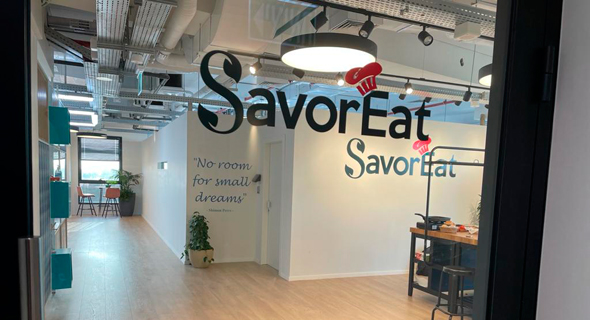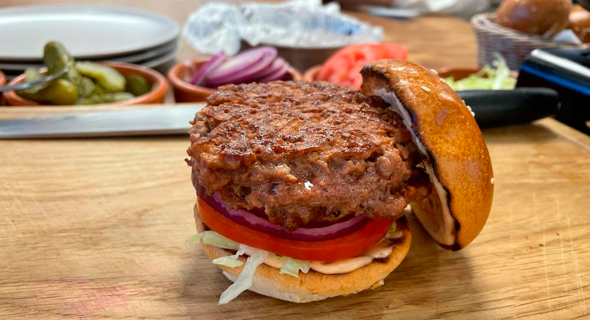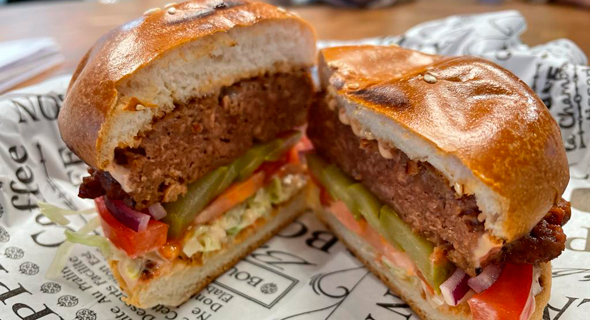Eating a 3D-printed burger - technically perfect, but something is missing
CTech was invited to SavorEat to eat a freshly printed 3D burger - here’s what we found
There’s somewhat of a revolution happening in the Israeli city of Rehovot. Just south of Tel Aviv, there is a flurry of companies in the foodtech sector that are working on a variety of plant-based or lab-grown alternatives to our conventional meat and dairy products. Their hope for the future is that humans no longer rely on the unhealthy, unethical, and environmentally unsustainable consumption of animals to feed a growing population.
One of them is SavorEat. Founded in 2018, the company works on creating plant-based meat substitutes that can be 3D printed in a matter of minutes. Their technology combines 3D printing, an automatic cooking machine (something between an oven and a robot), and personalized capsules storing ingredients that can be shipped out to places around the world.
 The SavorEat office in Rehovot, Israel. Photo: James Spiro/CTech
The SavorEat office in Rehovot, Israel. Photo: James Spiro/CTech CTech was invited to SavorEat’s offices to see for itself how their burgers get printed in only a matter of minutes before being ready to eat just like any other regular burger. Arriving just in time for dinner, we were introduced to Co-Founder and CEO Racheli Vizman.
The company and the cause
“It’s not just a gimmick,” she tells CTech as we explore the lab and sit at the main conference room, which is basically a large dining room with tables, chairs, and soft drinks readily available. Appropriate. “In 2017-2019, meat consumption rose by 5% whereas meat alternative products rose by 30%. We can see this is a trend and a trend that is here to stay.”
She’s right. Increasingly, younger generations are concerned about the health and environmental impact that large-scale meat consumption can have on a global scale. There are more than 100 million people in the U.S alone, 30% of the population, that are actively trying to incorporate plant-based foods in their diet. Recent years are showing there’s been almost a yearning for companies that can come out of the woodwork and provide a satisfactory replacement. She mentions competitors like Beyond Meat, Impossible Foods, and others that are already making a mark in places like McDonald’s and Burger King.
- As McDonald’s debut’s ‘McPlant’, here’s a look at the Israeli competition
- SavorEat raises over $12 million at $51 million valuation in first-ever Tel Aviv foodtech IPO
- Food For Mood: How myAir blends natural ingredients with artificial intelligence to manage stress
“Plant-based and meat alternative solutions can be tasty, healthy, and good for our environment,” she continues. “That’s part of the trend, continuing and speeding up development where you can see other companies involved in that disruption.”
SavorEat raised nearly $5 million before entering the Tel Aviv Stock Exchange - the first company of its kind to do so - in order to raise public awareness about meat alternatives. After going public, it raised $13 million and the company is now valued at roughly $50 million. Unlike something like a cybersecurity company, the product can be tangible, seeable, and tastable.
The taste test
Speaking of tastable. CTech is joined by CTO Moshe Aknin, VP R&D Doron Cohen, and Ilan Pinchas, Chef and a Senior VP at the popular Israeli burger chain BBB who works with SavorEat for culinary issues. With a table full of salads, vegetables, and burger buns, CTech is directed to the main event: the machine.
“The machine contains three products,” explains Aknin as we walk around the device. Unfortunately, photos are not allowed. “In the cartridges of the machine we are producing there will be three materials and you can have different combinations of meat. Then, you have the forming side… and then there’s the cooking side, which is the heater in the machine.”
According to Aknin, the machine CTech sees is somewhat of a prototype and the eventual commercial one will be six times faster, capable of cooking three burgers simultaneously in 3-5 minutes depending on how the customer likes it cooked. CTech orders a rare burger and customizes it to include less fat and more protein, and then we watch it print.
There are a few glitches in the preparation, and we are told that it didn’t happen in the previous prints that happened earlier that day. Once printed in its entirety, it is taken to Pinchas who prepares the patty as he would any other burger.
 A SavorEat burger. Photo: James Spiro/CTech
A SavorEat burger. Photo: James Spiro/CTech It is placed in front of CTech ready for consumption. Despite what it may look like, the patty is entirely vegan since it contains no trace of animal cells. The protein and fiber used in the cartridges don’t contain gluten, allergens, or antibodies, which makes it, in theory, the ideal meal to eat. In the future, cartridges won’t need to be refrigerated and so it will make storage and transport easy to manage.
The burger is cut in half for consumption - and Instagram - and a bite is taken. Technically, it is perfect. It is solid and juicy and the taste shines through like it would any other burger. It is impressively kept together as a patty and the additional efforts made by Pinchas make for delicious complements on the pallet. And yet, something is missing.
It was very ‘neat’. Not good for those who like messy or dirty burgers but tasty and enjoyable. It was perfectly cut and perfectly prepared, and perfectly stored, and perfectly delivered. And as Vizman explains, “if you have a chain of hotels or restaurants you can get the same product again and again.”
That, perhaps, is the biggest problem with a burger that is delivered via a data-driven 3D printer. It is technologically marvelous. Of course, it is impressive. Yes, it is tasty on a base level. But it lacks the complete art and effort made by chefs that makes food so special since “there is no involvement for the chef, saving time and effort. There is no human touch.”
SavorEat sees a future where burgers from a machine replace cuisines prepared by chefs or artists. They are personalized, but not personal. They are scientific, but not artistic.
 Inside the SavorEat burger. Photo: James Spiro/CTech
Inside the SavorEat burger. Photo: James Spiro/CTech The future of food
The item is still being tested since the company wants to be as ready as possible to deploy its machines and cartridges to the U.S and beyond. That means the employees at SavorEat conduct a lot of tests, and tastes, to make sure the world can one day become a healthier and more environmentally friendly place.
“I’ve gained seven kilos in the last six months,” says an unnamed employee. “I can’t eat it without the bun and mayonnaise. All day long we eat it, it’s really fun.”
SavorEat sees its main business model in the selling and subscriptions of their plant-based cartridges. Soon, the company wants to sell or lease its machines to hotels or restaurants that will depend on fast and effective cooking of large-scale meals. Eventually, the mission is to have a SavorEat machine in every kitchen, becoming a B2C company that helps the public make burgers at home like an espresso machine. The idea of that may be disheartening for some, but many people love their homemade coffee more than traditional coffee shops so who is to say that won’t happen someday to meat alternatives.
”The impact we want to create and the world we want to leave behind us is to develop a superior product in terms of health, the environment, and making the change we want to see in our world,” Vizman concludes. “I’m privileged to be part of this mission and getting to sleep every day smiling, feeling like I’m taking part in the revolution for all of us.”
Bon Appetite and Beta'avon to a technically perfect - albeit creatively void - future without meat.



